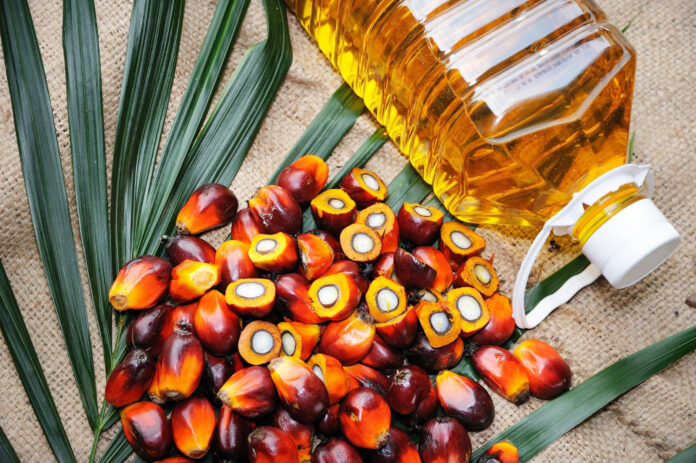Along the coast of West Africa, palm oil is not merely an ingredient but the foundation of cuisine and culture. In Yoruba villages of southwestern Nigeria, the deep red oil (epo pupa) colors soups like egusi and efo riro and enriches countless stews. Among the Igbo, it is ọfè mmanụ, literally “oil soup,” a name that doubles as a playful jab at the Yoruba, as we are known for pouring palm oil generously into our dishes. A soup that lacks the inviting red hue of palm oil is already “judged” before it is tasted. Therefore, a traditional meal without palm oil feels incomplete. Across the humid rainforest belt, from Nigeria’s Niger Delta to Ghana’s coast, palm oil has for centuries reigned as the dominant fat woven into tradition, agriculture, and daily life.
In West Africa, palm oil is celebrated, and its cultural visibility proudly announces itself in every meal. In the modern West, the story takes a different turn. Palm oil is stripped of its color, refined until bland, and hidden in the background of industrial food. It lurks in fried chicken, French fries, cookies, chips, margarines, instant noodles, and pastries, often disguised as “vegetable oil” on labels. The same oil that is visible and intentional in a Yoruba soup becomes invisible and stealthy in a Western snack. And that invisibility makes it easy to overconsume without even knowing it.
In the village setting, palm oil is eaten daily but always in the context of balance. Meals are modest and paired with tubers, beans, and leafy greens. More importantly, daily life involves constant movement such as walking to the farm, carrying water, or tending animals. In this context, palm oil doesn’t linger in the body. Muscles, acting like hungry furnaces, quickly burn it for energy or store it in small, safe amounts. Here, palm oil is fuel that flows through the system, leaving little trace behind.
The story changes in the modern West. Here, palm oil appears not as food heritage but as industrial filler, riding alongside sugar and refined starch. When diets are heavy in refined carbohydrates and sugary sodas, the liver converts the excess glucose into palmitate, the main saturated fatty acid found in native palm oil. In other words, even before the hidden palm oil in processed snacks, the body is already producing palmitate internally without ever needing a visiting visa to West Africa. The dose climbs higher, and the system begins to choke in a sedentary lifestyle.
It should be noted that palmitate alone doesn’t cause trouble. To emphasize the interconversion of macronutrients, the body can also produce serine, an amino acid, from sugar. With chronic overconsumption of processed carbohydrates, the combination of sugar-derived serine and palmitate gives rise to signaling molecules called ceramides. At baseline, ceramides stabilize cell membranes, form protective barriers in the skin, and even guide cells to self-destruct when they are too damaged to function.
The problem arises when ceramides accumulate beyond their healthy range. In overnutrition and inactivity, palmitate and serine overflow, and so does the enzymatic formation of excess ceramides. Instead of helping, ceramides begin to harm. Unlike glucose, ceramides persist much longer in the body, and when they accumulate in excess, they block insulin’s main signaling arm, keeping the liver producing sugar overnight while muscles simultaneously resist glucose uptake. This is why patients with type 2 diabetes often wake up puzzled, insisting they didn’t eat sugar for dinner. It’s not last night’s food; it’s the hidden chemistry of excess ceramides.
This contrast highlights why villagers who consume palm oil daily rarely show insulin resistance, while Western populations, flooded with sugar-derived palmitate and serine, struggle with diabetes and fatty liver disease. In one story, palmitate is an energy bearer that dissipates as heat in the active life of West Africans. In the other, it becomes a saboteur, stored and transformed into excess ceramides—the agents of insulin’s broken message in type 2 diabetes.
The lesson is not to demonize palm oil, ceramides, or sugar. The same molecules can be harmless or harmful depending on context. The difference lies in dose and lifestyle. The problem is that modern nutrition science often treats nutrients as one-way traffic. For instance, hummingbirds live mostly on liquid sugar, yet their sugar metabolism is never directed toward storage. Mother Nature gave us only three macronutrients: fat, protein, and carbohydrate, each carrying fiery reducing power that can burn beyond its purpose and spark metabolic disease when consumed in excess, whether alone or together. As they say in toxicology, the dose makes the poison.
Palm oil, like most of nature’s gifts, is neither hero nor villain. Its meaning changes with the hands that use it and the lives that surround it. In West Africa, it nourishes both body and culture, sustaining generations through rhythm, restraint, and movement. In the modern West, it is stripped of its soul, blended into anonymity, and swallowed in excess. The molecule remains the same, but the story shifts from balance to imbalance, from fuel to burden. What palm oil ultimately teaches is that chemistry is universal, but context is everything.



